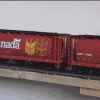
One of the first things I noticed on my first trip into Canada (for the convention C_ACE in Ottawa) was the preponderance of semi trucks with more than the usual 18 wheels you might expect on a tractor-trailer. Many trailers sported 3 and even 4 axles with no really discernable reason why. I eventually came to the conclusion that per-axle load limits were lower in parts of Canada than in the US overall.
Still, the image stuck in my mind enough so that one of my first sketchbook trades at that con poked a little fun at that observation, as in what other wheeled contraptions might be influenced by the centipede-like trailers found on Canada's highways. With that I present a heavily-reworked colored version of a sketch trade I did with henbe at C-ACE 2004's dead-dog party.
henbe at C-ACE 2004's dead-dog party.
Digitally traced from a scan of the original pencil-shaded sketch, with a digital backdrop added because the blank backdrop just didn't look right once colored, Cynthia tries to cope with the well-wheeled set of in-line skates I stuck her in, while one of the aformentioned semis cruises by in the background, (missing the snarky remark I included in the original :) )
(2016 Edit: #1 in the Weekly Pen & Pencil folder)
Still, the image stuck in my mind enough so that one of my first sketchbook trades at that con poked a little fun at that observation, as in what other wheeled contraptions might be influenced by the centipede-like trailers found on Canada's highways. With that I present a heavily-reworked colored version of a sketch trade I did with
 henbe at C-ACE 2004's dead-dog party.
henbe at C-ACE 2004's dead-dog party.Digitally traced from a scan of the original pencil-shaded sketch, with a digital backdrop added because the blank backdrop just didn't look right once colored, Cynthia tries to cope with the well-wheeled set of in-line skates I stuck her in, while one of the aformentioned semis cruises by in the background, (missing the snarky remark I included in the original :) )
(2016 Edit: #1 in the Weekly Pen & Pencil folder)
Category Artwork (Digital) / General Furry Art
Species Housecat
Size 750 x 981px
File Size 113 kB
I have theory on the multi axles. Up here we have weigh stations for trucks and weight limits for vehicles using highways. Our harsh wheather makes the roads more suspetible to deformations as it is supported by soft maniable ground. I believe the weigh stations divide the wieght by wheel to calculate weight distribution. More wheels means less wieght per wheel thus more freedom to carry heavier loads on faster highways.
Where I work we see a lot of these trucks that have "extra" axles, and there is a good reason why: They're carrying loads that a standard trailer cannot carry, (one supplier sends us shipments that are so dense that an 18-wheeler can only carry 12 skids, 7 over the real wheels and 5 over the hitch with the middle of the trailer empty).
You'll see trucks like this in the US, just look at what's used at places like smelters.
You'll see trucks like this in the US, just look at what's used at places like smelters.
Riding back home on I-87 I've noticed a fair number of tri-axle flatbeds heading back toward the border, and down here in New York City, I've seen Shell tankers with triple axles making deliveries to local gas stations.
The most visible example of multiple axles down here is on dump trucks, but in contrast with the ones I saw in Quebec and Ontario (with two steering axles up front) all of the 4-axle dump trucks here are single steering axle with 3 driving axles, with the second axle retractable as it's supposedly only used for additional starting traction in muddy/snowy conditions.
I have yet to see any 4-axle van or tanker trailers down here, (what you'll sometimes see is trailer axles spread far apart) and the gross weight for trucks is currently set at 80,000lb.
The most visible example of multiple axles down here is on dump trucks, but in contrast with the ones I saw in Quebec and Ontario (with two steering axles up front) all of the 4-axle dump trucks here are single steering axle with 3 driving axles, with the second axle retractable as it's supposedly only used for additional starting traction in muddy/snowy conditions.
I have yet to see any 4-axle van or tanker trailers down here, (what you'll sometimes see is trailer axles spread far apart) and the gross weight for trucks is currently set at 80,000lb.
Disclaimer: I did goof on the doubletrailer depicted in the pic--it's supposed to be a stretched-frame container carrier (dunno the formal name) with triple axles and a fifth wheel on the extension, but I drew it like a twin-axle dolly. I've seen one of these leaving Hunts Point in The Bronx, but without the second trailer (the only example so far that I've seen in the US)
Just poking around and found this...
I think you're referring to a B-train, then. When the first trailer has an extended tongue and fifth for a second trailer. It's much preferred over a pintle hook trailer or axle dolly because it creates a roll-coupling amongst all the components.
In other words, if any part of the vehicle gets a rolling force, trying to tip it onto its side, it has to force the entire collection onto its side, not just a single trailer. That makes it safer in sudden emergency maneuvers.
As the cab pulls each trailer in sequence through the turning point, they get hit with the sideways force in turn. If they were free to roll, each trailer would have to deal with the rollover force individually. When they're roll-coupled, the force on each unit gets distributed through the whole; Components before or after the turning point are either yet to take the side load, or are in recoil from it, thus dampening the side action and actually allowing stronger, snappier emergency maneuvers than decoupled trailers would.
It also resists 'wagging' the trailers as it resists the rolling motion that tends to amplify any random side-to-side wandering.
I think you're referring to a B-train, then. When the first trailer has an extended tongue and fifth for a second trailer. It's much preferred over a pintle hook trailer or axle dolly because it creates a roll-coupling amongst all the components.
In other words, if any part of the vehicle gets a rolling force, trying to tip it onto its side, it has to force the entire collection onto its side, not just a single trailer. That makes it safer in sudden emergency maneuvers.
As the cab pulls each trailer in sequence through the turning point, they get hit with the sideways force in turn. If they were free to roll, each trailer would have to deal with the rollover force individually. When they're roll-coupled, the force on each unit gets distributed through the whole; Components before or after the turning point are either yet to take the side load, or are in recoil from it, thus dampening the side action and actually allowing stronger, snappier emergency maneuvers than decoupled trailers would.
It also resists 'wagging' the trailers as it resists the rolling motion that tends to amplify any random side-to-side wandering.
That makes a whole lot of sense! Thaks for explaining it.
Makes one wonder why it hasn't caught on in the US though. I see a lot of 20-foot-ish doubles on the interstates here, almost all with single-axle dollies, (the twin-axle ones seem to be reserved for 40-45' doubles) and they do oscillate side to side quite a bit.
Makes one wonder why it hasn't caught on in the US though. I see a lot of 20-foot-ish doubles on the interstates here, almost all with single-axle dollies, (the twin-axle ones seem to be reserved for 40-45' doubles) and they do oscillate side to side quite a bit.
Laziness and cost, I bet, combined with reduced flexibility. They had them already, they're 'good enough', don't rock the boat mentality...
But yes, reduced flexibility. With a dolly, you can pop off the second trailer and stow the dolly, and you've got two stubby standard trailers, which can then be sent their separate ways on day cabs. With a B-train, you CAN separate them, but then you've got one standard and one freak-mutant trailer. Plus, they're usually found in matched pairs.
I know a bunch of oil services up here use B-trains because of the additional axles reduce the per-wheel tonnage, and I've seen a single B-train twin reefer for McDee's.
But yes, reduced flexibility. With a dolly, you can pop off the second trailer and stow the dolly, and you've got two stubby standard trailers, which can then be sent their separate ways on day cabs. With a B-train, you CAN separate them, but then you've got one standard and one freak-mutant trailer. Plus, they're usually found in matched pairs.
I know a bunch of oil services up here use B-trains because of the additional axles reduce the per-wheel tonnage, and I've seen a single B-train twin reefer for McDee's.

 FA+
FA+

















Comments